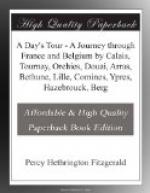But one of the pleasantest associations connected with the town was the old Dessein’s Hotel, which had somehow an inexpressibly old-fashioned charm, for it had a grace like some disused chateau. Some of the prettiest passages in Sterne’s writings are associated with this place. We see the figures of the monk, the well-known host, the lady and the petit-maitre: to say nothing of the old desobligeante. Even of late years it was impossible to look at the old building, which remained unchanged, without calling up the image of Mr. Sterne, and the curious airy conversation—sprinkled with what execrable French both in grammar and spelling!—that took place at the gate. An air of the old times pervaded it strongly: it was like opening an old garde de vin. You passed out of the place and found yourself in the Rue Royale—newly named Rue Leveux—and there, Dessein’s stood before you, with its long yellow wall, archway and spacious courts, on each side a number of quaint gables or mansardes, sharp-roofed. Over the wall was seen the foliage of tall and handsome trees. There is a coloured print representing this entrance, with the meeting of the ‘little master’ and the lady—painted by Leslie—and which gives a good idea of the place. In the last century the courtyard used to be filled with posting-carriages, and the well-known remise lay here in a corner. Behind the house stretched large, well-stocked gardens, with which the guests at the hotel used to be recreated; while at the bottom of the garden, but opening into another street, was the theatre, built by the original Dessein, belonging to the hotel, and still used. This garden was wild and luxuriant, the birds singing, while the courtyard was dusty and weed-grown.
This charming picture has ever been a captivating one for the traveller. It seemed like an old country-house transferred to town. There was something indescribable in the tranquil flavour of the place, its yellow gamboge tint alternated with green vineries, its spacious courtyard and handsome chambers. It was bound up with innumerable old associations. Thackeray describes, with an almost poetical affection and sympathy, the night he spent there. He called up the image of Sterne in his ‘black satin smalls,’ and talked with him. They used to show his room, regularly marked, as I have seen it, ‘STERNES’S ROOM, NO. 31,’ with its mezzotint, after Sir Joshua, hung over the chimney-piece. But this tradition received




